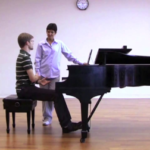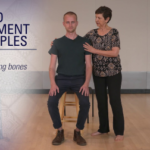Benefits and Research
The Alexander Technique attracts individuals wanting to improve mobility, ease postural discomfort, reduce chronic pain, and manage stress, while others seek lessons to advance their skills in the performing arts and athletic endeavours. Browse the menu lists below to learn more about how Alexander Technique can benefit you.
Use of resources
Please note that the content within the Research & Resources and Videos sections is provided only for general information purposes.
Use of Resources
Please note that the content within the Research & Resources is provided only for general information purposes. Many of the resources, such as books, are not free. Links to other websites or platforms are provided for viewers’ convenience, but ATC does not control or monitor them and accordingly cannot endorse their information or guarantee its accuracy and relevance. The use of content or links to third-party websites is at the viewers’ own risk. Viewers should contact an ATC-certified Alexander Technique teacher with any questions about the application of Alexander Technique to their specific issues.
Music
- Benefits
- Resources
- Videos
- Testimonials
Musicians have long known the powerful benefits of incorporating Alexander Technique when playing their instruments. It is very common to find Alexander Technique teachers working within important music institutions. Even just after a few lessons, musicians can hear an improvement to the sound they produce on their instrument when engaging with the Technique.
Excessive habitual tension during long hours of practicing and performance can frequently lead to pain and repetitive strain injuries for musicians, leading to setbacks in their careers. In fact, a study found that 86% of orchestral musicians experienced pain in the past 12 months while over 50% of the musicians reported living with chronic pain.
Often musicians unknowingly translate musical tension into physical tension so they can feel connected to the music. Engaging with Alexander Technique helps musicians to understand the need to change their physical approach to their instrument to relieve the pain, heal injuries or improve their playing. They learn to recognize and let go of their repeated muscular holding, commonly found in the neck, shoulders, arms, and back.
Musicians use Alexander Technique to move their bodies in a manner that is healthy and holistic to optimize their technical and expressive abilities. The Technique is well-suited to musicians as it helps improve attention, sensory awareness, and confidence, while mitigating performance stress. Musicians find that their musical tone becomes more expressive, their control improves, and their listening ability is enhanced when they can quieten the mind and body and work with the flow of the music instead of against it.
The Technique’s training in awareness also can help musicians notice how frequently they may practice on “auto pilot” where they let muscular memory take over when repeating a musical passage several times without necessarily engaging their minds. When this happens the musician is neither solving the technical problem of the passage nor in control of the music.
Since musicians are very sensitive to tonal changes to their instrument, they quickly hear the positive changes that are made when they use Alexander Technique in their practicing and performances. After a series of Alexander lessons, musicians will often find that they are able to tackle technically more challenging repertoire that had previously been inaccessible to them as a result of reducing unnecessary muscular tension.
As Gabriella Minnes Brandes astutely observes, “Musicians are the instruments that make sound. A piano, guitar, violin, cello or drum does not make sound until a musician utilises them. The ways musicians move and breathe determine the quality of contact between themselves and their instruments, and thus determine the quality of sound that is produced. When artists see themselves as the vehicle for their expression, as the instrument through which they express themselves, AT can provide them with specific ways to tune their instruments, creating spaces for new and creative explorations through music making.” (The Congress Papers – The 11th International Congress of the F.M. Alexander Technique)
Everyone wants to be right, but no one stops to consider if their idea of right is right.
– F.M. Alexander
General Articles
What Every Musician Needs to Know about the Body: The Practical Application of Body Mapping and the Alexander Technique to Making Music
Our body is the most immediate instrument of our mind. Every musical instrument is therefore an extension of our primary instrument (ourselves). If the primary instrument isn’t functioning properly, how can we expect the extensions to work?
– Domagoj Ivanovic, Violinist, Vancouver Opera
Cited in Brandes Minnes, G. (2019) Congress Papers- Advancing Global Perspectives. STAT Books: London, pp. 192-198
After years of practice focused on learning the oboe and performing, I developed severe back and shoulder pain. I understood my pain was somehow linked to the oboe but I had no idea why I was in pain – as far as I knew, I was just doing what I had been taught to do with an oboe. Something was obviously wrong, but I had lost any accurate sense about how I used my body when playing. My unconscious habits had taken over.
Studying Alexander Technique led me to a new way of practising and performing. I learned that how I think about my activity (playing the oboe, but any other activity as well) affects the quality of the activity. I learned to widen my attention while playing, to replace unnecessary tension and effort with ease and efficiency, to expand and soften instead of compressing and stiffening. The study and application of Alexander Technique has allowed me to become both a better technician and a better musician.
– David Owen, Oboist, Vancouver Opera






